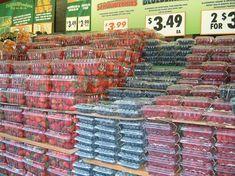
With domestic demand for berries continuing to increase, it has become imperative that suppliers meet retailer demand. The UK market has been hit particularly hard by the absence of product from Spain this year, however as the trend continues to source product globally, the retailers are managing their categories by selecting supply companies who are able to source globally themselves.
One such company is the US based fresh produce grower and exporter Driscoll’s.
Driscoll’s has achieved market leadership in the fresh soft-fruit sector by establishing growing and exporting partnerships across the globe. Purporting to have year-round supply of strawberries, raspberries and blueberries in both hemispheres, Driscoll’s has developed marketing alliances to ensure strong market growth over the last four years and established a platform to exploit future market opportunities.
Driscoll’s vice president of European Business, Dorn Wenninger says: “The seamless ability to supply from multiple geographies has helped us grow the category in partnership with our closest UK customers over the last 52 weeks.”
Driscoll’s has been able to fulfil market demand through a spread of production bases in the US, Chile, Argentina and Mexico.
Wenninger adds: “Spain had a very challenging season due to the weather and our producers, as well as the entire sector, were adversely affected. We’re still equally committed to Spain as a large source of our European production.What’s most important is that as a group, our global supply has helped us, and our close supermarket customers, continue to grow our collective soft-fruit sales in Europe again this year.”
Exports of berries from the US to the UK have been on the decline during the last few years (down around 25 per cent last year on 2003 export figures), however this does not reflect domestic UK demand.
The US is the largest strawberry producing country in the world, producing just fewer than 120 million trays a year, most of which are grown in California. Major international markets for US producers continue to be Canada and Mexico with the UK and South East Asia as significant secondary markets. The industry values itself at around £600m in sales per annum.
However only 14 per cent of the strawberry crop grown in the US is destined for global exports. Berry exporters suggest this low export rate is due to specific market demand for varietal and regulatory requirements in destinations such as continental Europe and the UK.
The most poignant reason is the size of the US market, coupled with ever growing Canadian and Mexican markets as neighbours - with trade made easier by NAFTA membership.
Export manager at Global Berry Farms John Shelford says: “European interest in strawberries from the US has been stagnant for the last few years. I believe this is primarily because US producers have difficulty meeting EurepGAP and UK regulatory requirements for pesticides.”
Movements in the US berry sector have seen the privately owned Dole Food Company buy-out a major berry competitor in California to now hold the title of the third largest strawberry grower, producing around 15 per cent of the US crop. Driscoll’s however, retains the title of the largest strawberry producer in the US.
Despite poor exports of US strawberries to Europe, demand for US blueberries is buoyant, and on the increase in recent years. Global Berry Farms, through its European partner Euroberry Marketing, has increased sales into Europe and the UK this year.
Driscoll’s strength in South American blueberries has allowed that area to be one of its largest areas of growth into Europe. In the last four years Driscoll’s has dramatically increased their imports of blueberries from Chile and Argentina to supermarket customers across Europe.
The US produces around 100,000 tonnes of blueberries each year, of which most is exported.
As demand for berries increases, with emphasis on specific eating and visual characteristics, so too has the establishment of proprietary varieties. These varieties are often developed with certain markets in mind, and, importantly, eating and shelf life characteristics.
Major US berry companies participate in production partnerships across Europe as well as the Americas, thereby establishing production bases close to the end market.
Wenninger says: “Working with partners in Spain, Morocco, Portugal, the UK, Ireland, Belgium, Holland, Germany, and South Africa we’re able to supply consumers with all the berries, year-round, from the closest source to our customers. The imports from the Americas are just one more resource that we have to meet our commitment to our customers.”
European volume potential is decidedly smaller than the local US, Canadian, and South American markets. US exporters therefore will continue to take an opportunistic approach to supplying the European and UK markets, and sell when they have excess products or when the market provides opportunities which can be exploited.
Opportunities do exist for smaller producers and exporters, however the competition from global sourcing does present volume issues which the smaller producer industry in the US is yet to overcome.
Berry sales continue to increase worldwide, with improved quality and the discoveries of health benefits being the major driving force behind the growth. Year-round supply, and larger pack sizes through “clamshell” packaging have also contributed to increased sales. The development and broad usage of clamshell packaging has enabled retailers to monitor, and display, berry products more easily, cutting down on bruising and extending shelf life.
Whilst the UK market is not a key focus for US producers, the marketplace needs to be mindful of US potential given the industry’s sheer size and global sourcing abilities. Should market opportunities exist, US producers are well positioned to gear up and exploit those opportunities in quick time.
The scope and depth of US berry producers ensures that they have an influence over the global marketplace, albeit that the focus in some products remains within the North American region. The flexibility that these companies have to quickly exploit market opportunities with excess production or market demand means that they are keeping a watching brief on the market.



